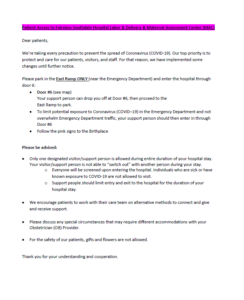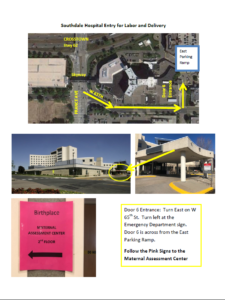Ectopic Pregnancy by Dr. Hanno
September 29, 2019AWH Launches New Website
August 16, 2020Pain Management Options in Labor and Delivery by Dr. Hanno
Pain is a normal part of the labor process, and each individual experiences labor pain differently. Talk with your obstetric provider about which pain control options might be right for you. Also, remember to keep an open mind during the labor process. Especially during your first labor experience, it is difficult to predict ahead of time exactly how you will experience labor pain, and exactly what the best option will be for you at that moment.
Non-Pharmacologic Options for Managing Labor Pain (non-medication options)
There are many options for managing pain during labor and delivery that do not involve medication. Even women who ultimately choose medication options will find these non-pharmacologic options helpful during the early stages of labor. Note that options are not limited to just this list. Your labor nurse is a great resource for deciding what options might be right for you during each moment of your labor process.
1. Support Person – A helpful, encouraging support person/labor coach can help with things such as verbal coaching/encouragement, gentle neck/back massage, and obtaining a cool cloth for your forehead or a sip of water. This support person can be your partner, a family member, friend, or doula.
2. Self-Soothing Techniques – Such as deliberate breathing techniques, or meditation techniques can be helpful for distracting you from pain. Some find music to be helpful.
3. Aromatherapy Options – Please check with the hospital first before bringing your own aromatherapy materials.
4. Laboring in a Tub – Depending on the hospital where you deliver, this may or may not be an option during your labor. This involves laboring in a tub to help soothe the pain of labor. Note that this is NOT a “water birth,” and you would not remain in the tub during the delivery process.
5. Varying positions during labor can be very beneficial. Depending upon the status of your baby and you, options can include walking during labor, sitting upon a “birthing ball,” and changing from lying to kneeling or standing/leaning positions.
Pharmacologic Options for Managing Labor Pain (medication options)
1. Nitrous Oxide – This is a self-administered tasteless/odorless gas that is inhaled through a mask. The laboring mom controls the timing of administration. Typically one places the mask approximately 30 seconds before the onset of each contraction, then removes the mask when that contraction has resolved. Nitrous oxide changes one’s perception of pain and can decrease anxiety about pain. It does not completely remove pain.
2. Analgesic Medications – These medications are given through either a shot or through an IV. The goal is to decrease pain and to have a calming effect. They are in the family of medications called opioids. However, note that receiving a few doses of these medications during labor will not cause you to become addicted to opioids. These medications typically provide relief for 1-2 hours, but they do not typically take the pain completely away.
3. Epidural Block – This involves medication given through a tube placed in your lower back. The epidural is placed by a special type of doctor called an anesthesiologist. The goal of an epidural is to block most pain. The typical effect is to block both sensation and pain. If you later need a cesarean, the epidural can usually be used to block pain during the surgery, and the dose must be modified for it to do so.
Of course, it is important to talk with our obstetric providers about the possible risks, side effects, and benefits of each type of pharmacologic option.


